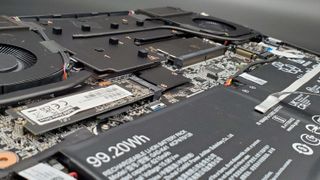The Gigabyte Aorus Master 16 is my first taste of the RTX 5080 mobile GPU, and while this might not end up being my favourite gaming laptop of this generation, the Nvidia graphics chip might well be. The GPU itself is capable of delivering the same sort of gaming performance that we’ve seen from the RTX 5090 in the excellent Razer Blade 16, though it does have to push its graphics silicon hard to get there.
And that means the actual experience of using the laptop isn’t quite such a pleasant one, that and the design of the Aorus Master 16 makes it feel like a very old notebook. It may have a glorious OLED screen, a powerful Intel Arrow Lake CPU, and possibly the best mobile GPU of this gen, but it’s a chonky thing that’s very reminiscent of the laptop designs from a decade ago. The construction is largely aluminium, but oh boy does that lid scratch super easily.
Sorry Gigabyte, just using the machine as my day-to-day working machine has resulted in the review sample getting horribly cut up without me doing anything careless with it.
But let’s take a moment to look at what’s inside this big ol’ gaming laptop. Obviously the headline spec is that 175 W RTX 5080 laptop GPU, but as with the previous generation—and many laptop generations past—there is no parity between desktop and mobile GPUs in terms of nomenclature or necessarily specs. The RTX 5080 mobile is closer to the RTX 5070 Ti, but it’s actually the chip which has the biggest disparity between equivalent desktop GPU and the mobile silicon.
Aorus Master 16 specs

Model no: AM6BYH
CPU: Intel Core Ultra 9 275HX
GPU: Nvidia RTX 5080 (175 W)
RAM: 32 GB DDR5-5600
Storage: 1 TB PCIe 4.0 SSD
Screen size: 16-inch OLED
Refresh rate: 240 Hz
Resolution: 2560 x 1600
Battery: 99 Whr
Dimensions: 23~29 x 357 x 254 mm | 0.90~1.14 x 14.05 x 10 inches
Weight: 2.5 kg | 5.51 lbs
Price: $3,100 | $2,900
The difference between the desktop RTX 5080 and the mobile RTX 5090 is 256 CUDA cores, or a 2.4% delta. The gap between the RTX 5070 Ti and the RTX 5080 mobile, however, is 1,280 cores or 16.7%. That is a sizeable drop in potential performance, and should also mean a considerable difference between what the RTX 5080 is capable of compared with the RTX 5090.
And it probably would do if both GPUs are given the same level of cooling, power, and clock speeds. But with a far smaller chassis, and much lower GPU frequency, the RTX 5090 in the Blade 16 is quite heavily restrained to fit that form factor, while the RTX 5080 in this big boi Gigabyte Aorus Master 16 can hit higher clock speeds without causing an issue in terms of the cooling, and that means it can hit the same fps notes.
In fact, it can remain super cool while gaming at high frequencies. The trade off, however, is when it comes to the aural experience of gaming on the Aorus. It be loud.
Complementing the RTX 5080 mobile silicon is Intel’s latest Arrow Lake HX laptop processor architecture, repped here by the Core Ultra 9 275HX. That’s a 24-core chip with a potential boost clock of up to 5.4 GHz, and actually proves to be a bit of a monster in terms of raw CPU performance. The Blender numbers show it far ahead of the Ryzen AI 9 chip in the Blade 16, and the same is true of the Cinebench performance—and if you check out the relative Baldur’s Gate 3 performance you’ll see what a difference it can make in CPU-limited titles, too.
Along with that you get 32 GB DDR5-5600 in two banks of SODIMMs, with just a 1 TB SSD inside. At least that gives you the option to expand memory going forward (with up to 64 GB possible) and, with a second M.2 slot inside, you can easily add in extra storage capacity. Though with this machine here costing more than $3,000 I would absolutely have expected to have 2 TB minimum in terms of storage.
I’m here for the bright 2560 x 1600 OLED display, however. It’s got the same high refresh rate, tight pixel pitch combo which makes the Blade’s screen such a peach. It’s accurate, sharp, and just looks fantastic in games and watching any HDR content. And there’s also no issue with just leaving HDR enabled permanently, either. The display is happily able to deliver a great SDR as well as HDR experience.
The connectivity is pretty decent—working in an office with dreadful Wi-Fi I’ve been grateful for the wired ethernet connection as an option—and a pair of Type-A USB ports and two USB4 Type-C ports (one Thunderbolt 5 and one Thunderbolt 4) is about the least I would hope for from a machine costing as much.
I’m not so enamoured with the rest of the package, though. The keyboard, in great contrast to the excellent Razer board, feels incredibly mushy and imprecise. The typing feel is rather unpleasant and I’m not particularly taken with the see-through QWERASD keys, either. There have also been times during benchmarking where I’ve had to hit a key multiple times in order to have it register, notably among the function keys.
And the promised ‘enormous touchpad’ feels like it’s been rather oversold. It’s a decent size, but certainly not deserving of the marketing moniker Gigabyte has attached to it. It is at least relatively responsive and, in fairness, the actually enormous trackpad of the Blade 16 does sometimes make it difficult to find the right-click portion of the pad with my digit-muscle memory not expecting it to be so far over to the side.
But what of performance? Well, it’s actually pretty stellar in terms of both gaming and productivity chops. As noted earlier, it’s generally delivering gaming frame rates at least on par with the RTX 5090 of the Blade 16, and sometimes even surpassing it.
That was something of a bugbear for me in the last generation when it came to the RTX 4090 vs RTX 4080 in laptop form; rarely did the top Nvidia GPU justify itself by comparison. The issue here is that the Gigabyte machine is running its graphics chip with a higher clock speed and with more power, and that results in a god-awful racket.
For any of the gaming benchmarks you can see in the results above, they were achieved using a system setting that even with a pair of serious noise-cancelling headphones you’d struggle to deem acceptable. That’s with the Performance fan setting, and I couldn’t bring myself to try the Turbo setting for fear the laptop would start levitating.
No human should ever run this laptop at those levels; the sound and the experience is utterly abhorrent. But that’s actually okay, because you don’t need to. The cooling inside the Aorus Master 16 is great and keeps the GPU incredibly cool while running in that extreme Performance fan mode… which makes doing so almost unnecessary.
Knock things back down, and stick things on the Silent fan setting and the experience completely changes. Yes, the GPU core does get a lot hotter—not to any dangerous level, however—and you will need to knock back the general performance level to rein in the Intel CPU, but the actual gaming performance doesn’t take too much of a hit. Losing around 20 fps when you’re already scoring native frame rates, without upscaling, that will top 60 fps that’s a hit I’m willing to take for the improved overall experience.
In my over-the-top Alan Wake 2 test, pushing all the graphics settings to their absolute max, things prove too much for the RTX 5080 in this rig in Silent mode even with Multi Frame Gen (MFG) in action. The frame rate is great, but the PC Latency becomes too high to make the gaming experience at all pleasant or particularly functional. That is too extreme a test, however, and knocking the settings back a touch, or even shifting to Performance DLSS settings will considerably improve things. And the fact that you can run the RT Overdrive path tracing mode of Cyberpunk 2077 at native resolution on this machine does show the power of MFG in making Silent mode gaming effective.
What I will say is that the Silent fan setting isn’t silent, but it is sooooo much quieter than the standard Performance mode the Gimate system software will enable as soon as you switch to Gaming mode.
MFG, and the general efficiency improvements of the Nvidia Blackwell architecture, also gives us effective gaming performance on battery, too. This, for me, is the main hallmark of this new generation of gaming laptops, and it’s present here even with the beefy Gigabyte Aorus Master 16. This sort of laptop rarely sees a PCMark 10 gaming battery life figure of over 100 minutes, yet here we are with an hour and a half of running a powerful discrete GPU.
And if you’re picking up the BatteryBoost setting, with its scene-aware algo, you can get a good level of actual gaming time from this machine away from the plug. Though it will take a ton of juggling between different Gimate settings screens, which can get tiresome when switching between plug socket and battery, especially given the somewhat opaque suggestion pop-ups that I’m rarely confident of clicking on.
Buy if…
✅ You want the performance and don’t care about the noise: It’s a loud beast, but if that doesn’t bother you, the Aorus Master 16 will deliver.
✅ CPU performance is important: The Intel Arrow Lake HX chip is a very impressive CPU in terms of raw processing grunt.
Don’t buy if…
❌ You want a sleek laptop: The chonky Aorus Master 16 anachronistic chassis might deliver on the cooling performance, but does make it feel like an older machine.
❌ Battery life is key: The RTX Blackwell GPUs do help on the efficiency front, but the Intel CPU weighs heavily on the other side of the scale, making it a tough machine to recommend for all day workloads.
What I will say, is that it’s not quite on par with the new Blade 16 or the Zephyrus G16 from the last generation, and a good part of that is down to the Intel CPU sitting alongside the Nvidia GPU.
Both the Blade and Zephryus machines deliver over two hours in the PCMark 10 benchmark, and share the same Ryzen AI 9 HX 370 processor; a chip that may not have the same straight line speed as the Intel Arrow Lake HX chips, but can certainly nail efficiency. It also offers the Radeon 890M iGPU, too, which means you can nix the discrete graphics silicon entirely for improved battery life on games that don’t require serious GPU grunt.
So, while the general performance numbers look outstanding for the Gigabyte Aorus Master 16, it’s not been a gaming laptop I’ve particularly enjoyed playing with. And that means it’s not one I’m going to be rushing out to recommend. Yes, that $3,100 price tag is considerably lower than the RTX 5090 Blade 16, but the RTX 5080 version is a lot closer in financial terms, and I’m still going to be leaning in that direction.
The physical device feels old and clunky, and the over-the-top fans could do with tuning down—which, admittedly, you can do manually—but if it was more of a budget option I’d be more happy to get onboard with its deficiencies. At this relatively high price I’m far more hesitant.
Source link











Add comment